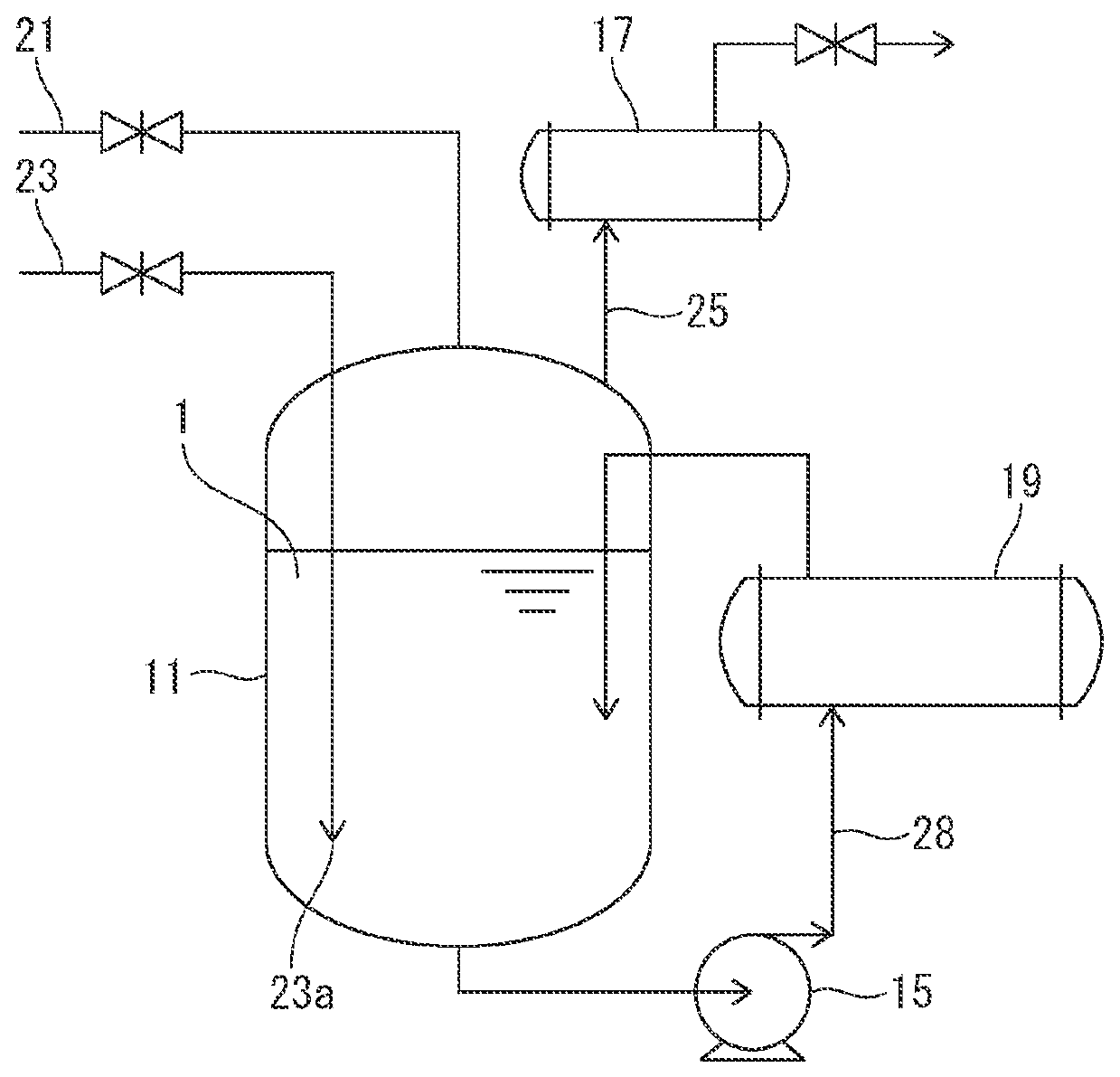Method for producing tetrafluoromethane
a technology of tetrafluoromethane and tetrafluoromethane, which is applied in the field of producing tetrafluoromethane, can solve the problems of large amount of reaction heat, low yield of tetrafluoromethane, and insufficient reaction heat generated by flames, so as to achieve stable, safe and inexpensive production of tetrafluoromethane
- Summary
- Abstract
- Description
- Claims
- Application Information
AI Technical Summary
Benefits of technology
Problems solved by technology
Method used
Image
Examples
example 1
[0065]Tetrafluoromethane was synthesized by using a reaction apparatus substantially the same as the reaction apparatus in FIG. 1 except that a heat exchanger 19, a circulation pipe 28, and a liquid circulating pump 15 were not included. In an SUS reaction container having a capacity of 1 L, 600 mL (1,030 g) of perfluoro-n-octane having a boiling point of 103° C. at normal pressure was placed, and to an outlet having a diameter of 1 mm and provided at an end of the fluorine gas pipe, an aggregated polyethylene (a low-density polyethylene (LDPE) manufactured by Aldrich) was attached as a reaction inducer. The content of the polyethylene used was 0.5% by mass where the total content of the perfluoro-n-octane and the polyethylene was 100% by mass.
[0066]From the fluorine gas outlet provided at an end of the fluorine gas pipe, fluorine gas was introduced to perfluoro-n-octane as a raw material liquid. The blowing flow rate of fluorine gas was set at 400 mL / min as converted at a temperatu...
example 2
[0070]Reaction was performed in the same manner as in Example 1 except that a reaction apparatus included a stirrer having three inclined paddle blades, and a powdery polystyrene was dispersed as a reaction inducer in the raw material liquid. The polystyrene was manufactured by Aldrich and was a powder having an average particle diameter of 250 μm. The content of the polystyrene was 0.5% by where the total content of the perfluoro-n-octane and the polystyrene was 100% by mass. To disperse the powdery polystyrene, the raw material liquid was stirred by using the stirrer at a rotation speed of 400 min−1.
[0071]When the introduction of fluorine gas was started, the temperature of the outlet increased to 200° C. The reaction was performed while the reaction container was cooled from the outside, and the reaction was performed while the temperature of the raw material liquid was maintained at 25° C., and the reaction pressure was maintained at normal pressure. As a result, the reaction wa...
example 3
[0075]Tetrafluoromethane was synthesized by using a reaction apparatus substantially the same as the reaction apparatus illustrated in FIG. 1. In an SUS reaction container having a capacity of 4 m3, 4,700 kg (2.8 m3) of hexafluorotetrachlorobutane was placed, and 33.1 kg of an aggregated polystyrene in total was attached as a reaction inducer to seven outlets each having a diameter of 5 mm and provided at an end of the fluorine gas pipe. The content of the hexafluorotetrachlorobutane used was 99.3% by mass and the content of the polystyrene used was 0.7% by mass where the total content of the hexafluorotetrachlorobutane and the polystyrene was 100% by mass.
[0076]From the outlets of a fluorine gas pipe, fluorine gas was introduced to the raw material liquid, and reaction was performed while the temperature of the raw material liquid was controlled at 60° C., and the reaction pressure was controlled at 0.2 MPaG. As the fluorine gas pipe, a ring sparger having seven outlets with a diam...
PUM
| Property | Measurement | Unit |
|---|---|---|
| temperature | aaaaa | aaaaa |
| pour point | aaaaa | aaaaa |
| pressure | aaaaa | aaaaa |
Abstract
Description
Claims
Application Information
 Login to View More
Login to View More - R&D Engineer
- R&D Manager
- IP Professional
- Industry Leading Data Capabilities
- Powerful AI technology
- Patent DNA Extraction
Browse by: Latest US Patents, China's latest patents, Technical Efficacy Thesaurus, Application Domain, Technology Topic, Popular Technical Reports.
© 2024 PatSnap. All rights reserved.Legal|Privacy policy|Modern Slavery Act Transparency Statement|Sitemap|About US| Contact US: help@patsnap.com








